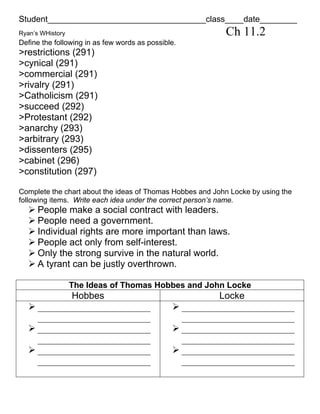
11.2 activity sheet
- 1. Student__________________________________class____date________ Ryan’s WHistory Ch 11.2 Define the following in as few words as possible. >restrictions (291) >cynical (291) >commercial (291) >rivalry (291) >Catholicism (291) >succeed (292) >Protestant (292) >anarchy (293) >arbitrary (293) >dissenters (295) >cabinet (296) >constitution (297) Complete the chart about the ideas of Thomas Hobbes and John Locke by using the following items. Write each idea under the correct person’s name. People make a social contract with leaders. People need a government. Individual rights are more important than laws. People act only from self-interest. Only the strong survive in the natural world. A tyrant can be justly overthrown. The Ideas of Thomas Hobbes and John Locke Hobbes Locke ________________________ ________________________ ________________________ ________________________ ________________________ ________________________ ________________________ ________________________ ________________________ ________________________ ________________________ ________________________
- 2. Mark each statement true or false. ___ Charles II began the period in England called the Restoration. ___ The people of England were hoping to have a Catholic king again. ___ The Glorious Revolution took place without anyone being killed. ___ During the time of William and Mary, Parliament passed the English Bill of Rights, which said that Parliament had control over English rulers. ___ By 1700, Parliament had given up most of its power. ___ During the 1700s, the prime minister ran the government in Britain. ___ The British system of limited constitutional monarchy did not last long. Reviewing facts: The _________________________________ was a political party that usually supported the Anglican Church. The __________________________________ stated that no ruler could tax the people without asking Parliament. The ______________________________________ granted religious freedom to some people. When Charles II became king, the ________________________ period began and the period without a king or queen ended. The __________________________ was a political party that wanted a strong Parliament instead of a Catholic ruler. The ______________________________________ was made up of leaders from Parliament who advised the monarch. Parliament passed the _______________________________ in order to protect the rights of people who had been arrested. As Parliament became more powerful, the __________________________ ran the government instead of the king or queen.
